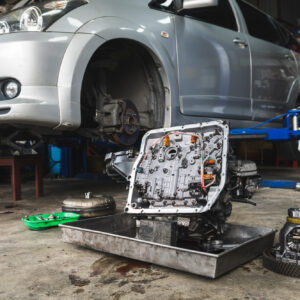BMW introduced many interesting automotive technologies over the years. One of them is the SMG transmission. Although it was only in service for a few years before giving way to a new design, the BMW SMG transmission promised the best of both manual and automatic transmissions.
What Does SMG Mean?
SMG stands for Sequential Manual Gearbox. This was BMW’s take on a type of manual transmission that limits the driver to shifting to the next higher or lower gear. By restricting shifting to sequential gears, a sequential manual gearbox allows for quick gear changes.
The History of the BMW Sequential Manual Gearbox
The SMG transmission debuted in 1996 in the E36-generation BMW M3. Known as SMG I, the first iteration was only made available in Europe.
Next came the SMG II. It was the first SMG transmission made available in the US market, equipping the 2004 BMW M3 of the E46 generation. The SMG offers refined performance, enabling faster and smoother gear shifting. It also improved overall reliability.
Last but not least is the SMG III. The final version of the BMW Sequential Manual Gearbox, the SMG III, appeared in the E60 generation of BMW M5 and M6.
While the SMG was defined as cutting-edge during its introduction, it quickly fell behind as automatic transmissions improved.
In 2010, BMW manufactured the last models with the SMG III transmission. The manufacturer switched to the Getrag dual-clutch transmission.
BMW SMG Transmission Specifications
The BMW Sequential Manual Gearbox is a manual gearbox with an automated clutch. Developed from BMW race vehicle transmissions. The SMG offers six speeds to choose from.
It reuses the S6S420G manual gearbox in the E46-generation BMW M3. The SMG added electro-hydraulic computer control to the transmission. In this arrangement, the computer sends electronic signals to hydraulic actuators. The actuators engage and disengage the clutch depending on the driver’s input. They also hydraulically shift gears.
There were two ways for the driver to operate the SMG transmission. In the first method, the driver could pull on two paddles behind the steering wheel. Alternatively, the driver could move the floor shifter forward or backward.
Common BMW SMG Transmission Issues
The BMW Sequential Manual Gearbox is a complex system with parts that work together to deliver the shifting performance intended by the manufacturer. If one of the transmission parts fails or wears out, the rest of the gearbox will have problems.
Here are the most common problems with BMW SMG transmissions:
SMG Pump Failure
One of the most vulnerable parts of the BMW SMG transmission is its pump. Similar to automatic transmissions, the SMG pump generates the hydraulic pressure needed to engage gears. The pump wears out over the years, leading to mechanical issues.
When the SMG pump develops a problem, it might activate the transmission warning light. It might also cause issues, such as delayed gear shifting, the transmission becoming stuck in gear, or failing to shift.
Clutch Wear
The clutch is another part of the SMG transmission that commonly causes problems for drivers. It’s automatically operated by the transmission control module, leading to a higher rate of wear than a clutch in an older type of manual transmission. Driving aggressively and in heavy traffic with frequent abrupt stops will wear out the clutch even faster.
A worn SMG clutch may cause issues like slipping gears, delayed shifting, and delayed engagement. Always check the clutch regularly and replace it as soon as it is needed to avoid major transmission problems.
Software Problems
A computer runs the automated processes of the BMW SMG transmission, such as engaging and disengaging the clutch. While it takes a load off the driver, the computer can develop software issues, causing problems like erratic and harsh shifting.
Updating the computer’s software can fix these issues. However, BMW discontinued support for the SMG transmission years ago. If you need to repair a software problem, you might have to find a third-party service provider that you can trust.
Temperature Sensor Failure
Transmissions need to remain within a recommended temperature range. The SMG transmission uses a sensor to measure the hydraulic unit’s temperature, so it can adjust the transmission’s performance and warn the driver about possible overheating.
A bad temperature sensor can have issues like inaccurate readings, intermittent signals, and outright failure. It can hamper the shifting process, making driving more difficult.

Transmission Fluid Leaks
The SMG transmission relies on hydraulic pressure to operate its many parts. If the unit develops a leak, the gearbox can lose pressure and transmission fluid. Insufficient pressure will reduce the transmission’s performance, causing issues like delayed or erratic shifting. Similarly, if the hydraulic fluid level drops too low, the transmission might overheat or get damaged.
Clutch Slave Cylinder Problems
The BMW SMG transmission has a clutch slave cylinder that assists the clutch master cylinder during clutch engagement. If the slave cylinder fails, it can stop the clutch from engaging correctly. This can happen after replacing a bad clutch. In the worst-case scenario, you might have to pull the transmission again.
Hydraulic Accumulator Problems
The clutch hydraulic accumulator dampens the force applied by hydraulic fluid pressure as the clutch engages. Unfortunately, the accumulator might overflow during a transmission fluid change. You must bleed and manage the SMG transmission to prevent issues with its accumulator.
Which Models Carry the BMW SMG?
Interested in trying out the SMG transmission? The following BMW models received the Sequential Manual Gearbox:
- BMW 3-series E46 (except for 2002)
- BMW Z4 E85
- BMW 5-series E60
- BMW 6-series E63
Any information provided on this Website is for informational purposes only and is not intended to replace consultation with a professional mechanic. The accuracy and timeliness of the information may change from the time of publication.



















